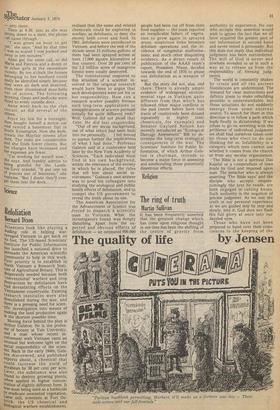Science
Refoliation
ternard Dixon
Scientists look like playing a leading role in helping warravaged Vietnam to get back on its feet. The US-based Scientists' Institute for Public Information has launched a national drive to Persuade the American scientific ,c9Mmunity to help in this work. first priority is to establish in 1\lorth Vietnam a Research Institute of Agricultural Botany. This is ,desperately needed because both conventional' warfare and crop destruction by defoliation have had devastating effects on the Vietnamese countryside. Existing research institutes were also demolished during the war, and there is a pressing need for scientific investigation into means of Plaking the land productive again in the shortest possible time. Moving force behind the plan is Arthur Galston. He is the professor of botany at Yale University, and a man whose recent involvement with Vietnam casts an unusual but welcome light on the sOcial responsibility of the scientist. Back in the early 1940s, Galstort discovered, and published reports about, a chemical that could increase the yield of s.,03rabean by 30 per cent per acre. Later, the substance was also found to destroy growing plants, When applied in higher concentration of slightly different form. It Was soon being used as a herbicide tO eradicate unwanted vegetation. Later still, scientists at Fort DeLtrick, the US chemical and biological warfare establishment,
realised that the same and related chemicals could be exploited in warfare, as defoliants, to deny the enemy both cover and food. In 1961, defoliants were introduced to Vietnam, and before the end of the decade some 15 millions gallons of them had been sprayed across at least 17,000 square kilometres of that country. Over 20 per cent of the 1.2 million acres of mangrove forests were totally destroyed.
The conventional response to this situation of a scientist involved in the original research would have been to argue that such developments were not his or her responsibility. How can a research worker possibly foresee such long-term applications or misapplications of science pursued initially for quite different ends? Well, Galston did not plead that case. He did feel responsible.
"Out of my social background, out of what ethics had been built into me personally ... I felt moved to pursue further the implications of what I had done," Professor Galston said at a conference held later by the New York Academy of Sciences. "Each individual must find in his own background, within the relevance of the society in which he is placed, the rules that tell him about social involvement." Galston's own answer was to prod his colleagues into studying the ecological and public health effects of defoliation, and to compel the US goveVnment to reveal the truth about its use.
The American Association for the Advancement of Science was .forced to dispatch a scientific team to Vietnam. What the investigators found was deeply disturbing. Apart from " the expected and obvious effects of defoliation — an estimated 600,000 people had been cut off from their food supplies — the team reported an inexplicable failure of vegetation to grow again in sprayed areas; suspicious links between defoliant operations and the incidence of congenital malformations; and much other disquieting evidence. As a direct result of publication of the AAAS team's report, President Nixon decided towards the end of 1970 to phase out defoliation as .a weapon of war.
But the story did not, alas, end there. There is already ample evidence of widespread environmental rape in Vietham quite different from that which has followed other major conflicts in the past (never before have vast tracts of countryside been doused repeatedly in highly toxic chemicals, for example) and Senator Gaylord Nelson has recently introduced an "Ecological Damage Assessment" Bill to determine the long-term ecological consequences of the war. The Scientists' Institute for Public Information, of which Arthur Galston is chairman, intends to become a major force in assessing and ameliorating those potentially disastrous effects.


























 Previous page
Previous page